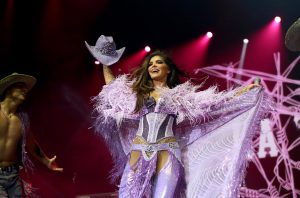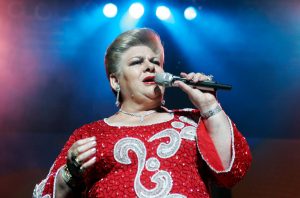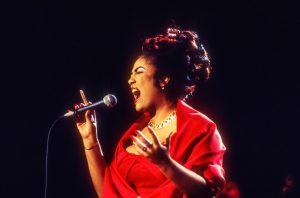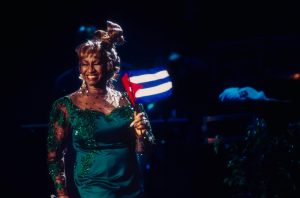As Women’s History Month draws to a close, what better way to honor the extraordinary contributions of women than by celebrating the female pioneers, visionaries, and stars who have defined Latin pop? From powerful ballads to timeless dance hits, these incredible artists have shaped the genre, empowering listeners and inspiring generations through their lyrics, voices, and artistry. On March 31, we proudly present our staff picks list of the Best 50 Female Latin Pop Artists of All Time as a fitting tribute to the women who have shattered glass ceilings and barriers with their music.
But what exactly is Latin “pop”? Pop music is “characterized by a strong melody and beat, and the use of electric instruments and amplification,” as defined by the Oxford English Dictionary; and is “distinct from other forms of popular music.” Most pop music falls into the category of catchy, tight, memorable music with broad appeal. As far as “Latin pop” goes, it is basically pop, en español. And while distinct from other genres like rock, dance, tropical and reggaetón, the word “pop” essentially means “popular,” and applies to music that transcends genre confines.
It’s a hazy description, we know, and Billboard’s Latin editors debated for weeks the merits of who should be on this list; who, among hundreds of names familiar to fans across the continent, should enter the pantheon of the top 50.
In creating the list of best female Latin pop artists of all time, we looked at artists who had, first and foremost, built a catalog that’s stood the test of time. There are several new artists who we think have a brilliant future ahead of them, but could not make this list on the merits of just one or two albums. Others are great artists, but their still-limited output — say, three albums or fewer — automatically moved them lower in the list.
We also focused on artists whose music had inspired others and created long-lasting trends; who boasted unique, outstanding vocals; and who had, for the most part, significant impact on the Billboard charts. Major chart achievements meant a higher position on the chart. We also included a handful of artists that aren’t essentially pop in genre, but whose impact was such that it transcended into the realm of mass popularity, at least within the scope of Latin audiences.
Artists like Celia Cruz, the undisputed Queen of Salsa, captivated global audiences with her Afro-Caribbean rhythms at a time when salsa was primarily confined to Latin American markets. Shakira took Latin pop to unprecedented heights by combining Colombian influences with — in the case of the groundbreaking, Billboard Hot 100-topping “Hips Don’t Lie” — reggae and hip-hop elements. Similarly, Selena, hailed as the Queen of Tejano Music, brought regional Mexican sounds into the mainstream with hits like “Amor Prohibido” at a time when Spanish-language music struggled to cross over in the United States.
Then there’s Gloria Estefan, whose contributions in the ’80s and ’90s set the foundation for the global rise of Latin pop. In 1992, she made history as the first Latina performer at the Super Bowl halftime show. Decades later, Karol G became the first woman since Selena to top the Billboard 200 chart with 2023’s Mañana Será Bonito, a Spanish-language album, while achieving the unprecedented feat of becoming a global stadium performer — an historic moment for Latina artists.
That said, in compiling this list, we set clear criteria to spotlight female Spanish-language artists — focusing on Latin pop’s influence within the Hispanophone world. While we deeply appreciate artists from Portuguese-speaking countries such as Brazil and their contributions to music, this specific list focuses on performers who are Spanish-speaking or who have consistently recorded music in Spanish.
Additionally, we made a concerted effort to focus on Latin pop by excluding hip-hop/urbano and folk singers, with two notable exceptions. Ivy Queen, widely known as the Queen of Reggaetón, earned her place thanks to her versatility and pop-forward hits that helped globalize the Puerto Rican genre as its leading female pioneer. Similarly, Mercedes Sosa, the iconic Argentine folk singer, transcended her roots and entered the realm of Latin pop through her immense cultural impact and widespread acclaim.
The Billboard Latin and Billboard Español teams took into account criteria like body of work/achievements (chart placements, awards, certifications); cultural impact/influence (how each artist’s work advanced Latin pop’s evolution and inspired cultural movements); longevity (staying power across decades and relevance in different eras); musicianship and vocal prowess (their unmistakable skill and charisma); and innovation (artistic evolution and originality within the genre).
So, without further ado, here are our picks for the Best 50 Female Latin Pop Artists of All Time!
-
Javiera Mena

Image Credit: Jordi Vidal/Redferns Few artists have captured the essence of Latin indie pop like Javiera Mena, whose earworm-y synths and whimsical lyricism revolutionized the genre. Born in Santiago, Mena emerged in the mid-2000s as a key architect of Chile’s indie pop golden age, combining lush melodies and unapologetic queer narratives. Her 2006 debut, Esquemas Juveniles, is hailed as a Latin alt-classic for elevating pop’s emotional core while defying commercial conventions.
But it was her sophomore release, Mena (2010), that cemented her status as one of Latin America’s most visionary indie pop auteurs, drawing comparisons to landmark albums like Café Tacvba’s Re. With tracks like “Luz de Piedra de Luna,” “Hasta La Verdad,” and the queer anthem “Espada” from Otra Era (2014), Mena imbued electopop with rare emotional intimacy. A performer, songwriter, and producer, she inspired countless acts in Chile’s indie boom, like Alex Anwandter, Gepe, Dënver, Adrianigual and Astro. Always unapologetically herself, her identity shines throughout her music, solidifying her role as a leader for LGBTQ+ representation. Though never mainstream, Javiera Mena is proof that indie pop doesn’t have to conform to dominate; it can instead transcend. — ISABELA RAYGOZA
-
Ángela Aguilar

Image Credit: John Parra/Getty Images for Univision The youngest of the Aguilar dynasty, Ángela – daughter of Pepe Aguilar and granddaughter of Antonio Aguilar and Flor Silvestre – has cemented her spot as a regional Mexican fixture, and one of the most successful female acts in the male-dominated genre. Regal onstage, even making singing rancheras while riding a horse look effortless, the 21-year-old’s vibrant falsetto is both commanding and enchanting, making her one of the strongest vocalists of her generation.
A touring force with back-to-back U.S. arena tours (Jaripeo Sin Fronteras and Jaripeo Hasta Los Huesos) — a family show conceived by Pepe in 2018 — Ángela’s presence on the charts is just as remarkable. So far, she’s landed three No. 1 songs on Billboard’s Regional Mexican Airplay chart and four top 10 hits on Latin Airplay, including her first No. 1 on that chart, “Por El Contrario,” with Leonardo Aguilar and Becky G last year. Aguilar is the youngest artist on this list, and age is the primary reason why she has not placed higher. But as a now-adult artist in the midst of an evolution, expect her to rise in the years to come. — GRISELDA FLORES
-
Yuridia

Image Credit: Medios y Media/Getty Images Whether you’ve been following Yuridia since her time in the competition show La Academia (2005) or are just discovering her music, the Mexican singer’s extraordinary vocal range and emotive way of interpreting ballads will instantly capture your attention. Since releasing her debut album La Voz de un Ángel exactly 20 years ago, Yuridia has become a sort of shape-shifter in the industry recording ballads, pop and, most recently, regional Mexican music. Working in the latter genre propelled Yuridia’s return to the top 10 on Billboard’s Latin Airplay chart after over a decade and a half, when “Qué Agonía,” a ranchera with Ángela Aguilar, peaked at No. 10 on the tally and at No. 5 on Regional Mexican Airplay. The song is part of the album Pa’ Luego es Tarde (2022), which debuted at No. 7 on the Regional Mexican Albums chart, her first entry on that chart. — G.F.
-
Alicia Villarreal

Image Credit: Medios y Media/Getty Images Villarreal stepped into stardom in 1994 as the lead vocalist of Monterrey-based Norteño band Grupo Límite. After gaining traction with songs such as “Te Aprovechas” and “Ay! Papacito,” and with her flirty catch phrase “ah-hah,” Villarreal pursued her solo career. The singer-songwriter’s debut album, Soy Lo Prohibido (2001), earned Villarreal the No. 1 spot on the Billboard Regional Mexican Albums chart and peaked at No. 3 on Top Latin Albums. Meanwhile, the set’s “Te Quedó Grande la Yegua” — a powerful mariachi that confronts the machista man — has become one of her career staples, one that still resonates today. Last year, Villarreal’s “Ojo Por Ojo” charted on the Regional Mexican Airplay chart, solidifying her space in the música Mexicana realm. — JESSICA ROIZ
-
Becky G

Image Credit: Emma McIntyre/Getty Images for Coachella As one of Latin music’s most versatile voices, Becky G has seamlessly bridged cultures and sounds while transforming into a global superstar. Born and raised in Inglewood, California, as Rebbeca Marie Gomez, Becky first introduced herself as a rapper in her early teens, delivering verses inspired by her Mexican-American upbringing. Her breakout came through her English-language single “Shower” in 2014, which reached No. 16 on the Hot 100, cementing her as an emerging hitmaker.
However, her artistic evolution truly began with bold forays into reggaetón, catapulting her into the Latin music mainstream. Collaborations such as “Mayores” with Bad Bunny (No. 74 on Hot 100) and “Sin Pijama” with Natti Natasha (No. 70 on Hot 100) became milestone hits. Songs like the billion-stream “MAMIII” with Karol G — which reached No. 1 on Hot Latin Songs — proved her ability to dominate both streaming platforms and charts. Continuing to expand her horizons, the 28-year-old more recently embraced música Mexicana, and became a representative of dos culturas with authenticity and pride. — I.R.
-
Anitta

Image Credit: Mauricio Santana/Getty Images The list of Brazilian artists who have conquered the Spanish-speaking marketplace is woefully small, for reasons too long to expound upon here. In the past two decades, none have been as successful as the relentless Anitta, who has been willing to invest time and effort into perfecting both her Spanish and English, and exploring a cornucopia of sounds without straying too far from her native Brazilian funk. While Anitta has been releasing albums for at least 10 years, she came to Latin attention in 2017 with “Downtown” alongside J Balvin, which peaked at No. 14 on Billboard’s Hot Latin Songs chart. At first, it would have been easy to dismiss this as a novelty. But through impactful collaborations and clever solo output (including “Envolver,” which reached No. 2 on Billboard’s Global 200 chart), Anitta’s sound has become the ingredient you didn’t know was missing from Latin pop. — LEILA COBO
-
Ednita Nazario

Image Credit: GV Cruz/WireImage Ednita Nazario is a renowned Puerto Rican singer, songwriter, and actress from Ponce, Puerto Rico. With her powerful and sweet voice, she has significantly influenced a generation through her romantic ballads. Her heartfelt vocal style expresses a range of emotions, establishing her as a prominent figure in the music industry. Best known for timeless hits like “Lo Que Son Las Cosas,” “Más Mala Que Tú,” “Tú Sabes Bien” and “Si No Me Amas,” Ednita launched her career in the vibrant Latin music scene of the 1980s. Over her three-decade-long career, she has released numerous successful albums, including Desnuda, El Corazón Decide and Real. Her versatility allows her to blend pop, ballads and rock, showcasing her ability to adapt to the evolving musical landscape. — INGRID FAJARDO
-
Natalia Jiménez

Image Credit: Gladys Vega/Getty Images Natalia Jiménez is a renowned Spanish singer and songwriter, who first became known as the lead singer of the popular Latin pop group La 5ª Estación. Born in 1981 in Madrid, Spain, she gained fame in the early 2000s with hits like “Inmortal” and “El Sol No Regresa.” After the group disbanded, Jiménez successfully launched a solo career, releasing critically acclaimed albums and earning multiple Latin Grammy nominations. Her powerful vocals and her ability to blend pop with traditional Latin influences have solidified her status as one of the leading voices in the Latin music industry. — I.F.
-
Milly Quezada

Image Credit: Jack Vartoogian/Getty Images Quezada kicked off her career in the late ‘70s as part of merengue band Milly, Jocelyn & Los Vecinos alongside her sister Jocelyn. In the ‘90s, she embarked on her solo career and has since positioned seven albums on the Tropical Albums chart and nine songs on Tropical Airplay, including “Para Darte Mi Vida” in collaboration with Elvis Crespo, which peaked at No. 2 in 1998. Dubbed the Queen of Merengue, the Dominican artist is behind classic party tunes such as “Entre Tu Cuerpo y El Mio,” “Volvio Juanita” and “Lo Que Más.” Quezada is a three-time Latin Grammy winner. — J.R.
-
Carla Morrison

Image Credit: Riccardo Savi/Getty Images for The Latinx House With a voice like a tender whisper and songwriting that feels utterly divine, Carla Morrison became one of Latin America’s most beloved indie stars of the 2010s. Hailing from Tecate, Baja California, the Mexican border-town songstress first enchanted audiences with her soulful, folky tunes and poignant lyrics. Her breakthrough came with her Grammy-nominated 2012 album Déjenme Llorar, featuring ethereal hits like “Eres Tú” and “Hasta la Piel,” solidifying her rep as an indie darling.
Though her rise was unconventional — marked by struggles to gain attention in a pop-dominated industry — Morrison ultimately defied odds to capture hearts worldwide. She expanded her reach with powerhouse collaborations like “Vibras,” the title track of J Balvin’s game-changing 2018 album, and Karol G’s “Mañana Será Bonito,” which marked her first Hot 100 entry at No. 98 and peaked at No. 19 on Hot Latin Songs. Morrison continues to redefine vulnerability, proving that it’s its own kind of strength. — I.R.
-
Mon Laferte

Image Credit: Medios y Media/Getty Images With a voice that channels raw emotion and fearless experimentation, Mon Laferte has emerged as one of Latin America’s most audacious artists. Born in Viña del Mar, Chile, Laferte first gained recognition with Desechable (2011) and Tornasol (2013), which earned her comparisons to Amy Winehouse for her jazz-, blues-, and rock-infused sound. However, it was her self-titled 2015 album that marked her transformation into a powerhouse following her move to Mexico. With gut-wrenching tracks like “Amor Completo” and “Tu Falta de Querer,” she captivated audiences with her ability to channel pain and passion into unforgettable lyricism.
From charting on Billboard’s Top Latin Albums with La Trenza (2017, No. 12) and Norma (2018, No. 24), to scoring a hit on Regional Mexican Airplay alongside Alejandro Fernández on “Que Se Sepa Nuestro Amor,” her music showcases her versatility across genres, including mambo, rancheras, and salsa. Her 2023 release, Autopoiética, ventures into trip-hop, cumbia rebajada, reggaetón and even touches of opera, while exploring themes of self-worth, identity, and the immigrant experience. Fierce, tattooed and unapologetically herself, Mon Laferte is a visionary artist whose voice mesmerizes and whose artistry consistently breaks norms. — I.R.
-
Alaska

Image Credit: Paco Junquera/Cover/Getty Images There’s no better embodiment of mainstream rebellion and reinvention in Spanish music than Alaska, the fearless artist who emerged during Spain’s transición from Franco’s dictatorship. As an emblematic leader voice of La Movida Madrileña — a punk-led movement that embraced freedom, irreverence, and counterculture in the post-dictatorship era — she became an icon of unapologetic individuality. With her avant-garde aesthetic and subversive lyrics, her group Alaska y los Pegamoides, whose 1982 smash “Bailando” fused punk and disco into an electrifying anthem. Over three decades later, its visionary appeal proved timeless, entering Billboard‘s Spain Digital Song Sales chart in 2018 at No. 5.
Beyond music, Alaska’s influence permeates Spanish media and arts: from hosting irreverent TV shows (Alaska y Mario) to appearing in Pedro Almodóvar’s early films (Pepi, Luci, Bom and Other Girls on the Heap), she epitomized Spain’s bold experimentation in the ‘80s. Her evolution into Alaska y Dinarama (with hits like “Ni Tú Ni Nadie” and the Thalia-covered “¿A Quién Le Importa?”) and later Fangoria, a dark synth-wave act, cemented her as a creative shapeshifter, blending genres and eras with ease. Alaska stands as a punk feminist and provocateur, a voice for artistic innovation that continues to resonate across generations. — I.R.
-
Rocío Jurado

Image Credit: Gianni Ferrari/Cover/Getty Images When Rosalía opened the Latin Grammys in 2023 with a stunning performance of “Se Nos Rompió el Amor” accompanied by cellists and flamenco dancers, she was channeling the late great Rocío Jurado, who also launched her career in flamenco in the 1960s before turning to pop fare that made her an international sensation in the Spanish speaking world. It was a move that would set the stage for dozens of artists who followed, marrying their roots to a pop sensibility that could bring them international acclaim. Jurado had big, multi-range voice that could traverse many genres, but she was also a savvy marketer that understood the importance of branding. Early in her career, she eschewed traditional flamenco garb for more contemporary, flamboyant outfits and became known as a sensational performer that sold out Madison Square Garden and performed for U.S. president Ronald Reagan.
Known in Spain as “la más grande,” the biggest, Jurado died at 61. But in filmmaker Pedro Almodovar’s words: “Women like her do not die. Rocio Jurado forms part of the biography of this country, together with [singers] Rocio Durcal (who died in 2006) and Lola Flores (who died in 1995).” — L.C.
-
Lucero

Image Credit: Carlos Tischler/NurPhoto via Getty Images Nicknamed “La Novia de América,” the Mexican singer and actor conquered hearts in Latin America thanks to her sweet and ethereal vocals that powered songs like “Cuéntame,” “El Privilegio de Amar” and “Electricidad.” With a decades-long career, as both a telenovela superstar and singer, Lucero helped fuel Mexico’s pop domination of the 80s and 90s. And she didn’t just live in the pop realm — her extraordinary influence as one of Mexico’s most beloved songstresses allowed her to extend her reach, recording ballads and regional Mexican music. All told, Lucero has a total of 16 entries on Hot Latin Songs, six out of those reached the top 10, including “Veleta,” which peaked at No. 2 in 1993. On Top Latin Albums, she has 11 entries, three of which entered the top 10. — G.F.
-
Omara Portuondo

Image Credit: Lorne Thomson/Redferns Omara Portuondo gained worldwide recognition in 1997 as part of Buena Vista Social Club, a project organized by World Circuit executive Nick Gold, produced by American guitarist Ry Cooder, and directed by Juan de Marcos González, who brought together a dozen veteran Cuban musicians to showcase styles such as son, bolero, and danzón. The group’s self-titled debut album quickly became an international phenomenon, reaching No. 1 on Billboard‘s Tropical Albums, where it stayed for 24 weeks, and also topping the Top Latin Albums and World Albums charts. It spent 19 weeks on the Billboard 200 and won the Grammy for Best Traditional Tropical Album and the Billboard Latin Music Award for Tropical/Salsa Album of the Year by a Group.
But at the time, Portuondo, then 65, already had a brilliant career. An essential figure in Havana’s jazz scene during the mid-20th century, she was an integral part of the filin movement — hence her nickname, “The Bride of Filin” — which created a new type of cosmopolitan bolero that incorporated Cuban swing into jazz-influenced songs. She was also a member of the all-female quartet Las D’Aida, alongside her sister Haydee, Elena Burke and Maraima Secada, performing at the iconic Tropicana, touring internationally and once appearing on The Steve Allen Show.
In her post-Buena Vista era, she reappeared on the Billboard charts with the albums Buena Vista Social Club Presents Omara Portuondo (2000) and Flor de Amor (2004), which entered Top Latin Albums (No. 3 and No. 70, respectively), Tropical Albums (No. 2 and No. 7), and World Albums (No. 2 and No. 6). Portuondo bid farewell in 2019 with the tour Omara is Cuba – The Last Kiss. Still alive at 94, her story goes on through the new Broadway musical Buena Vista Social Club. — SIGAL RATNER-ARIAS
-
Kali Uchis

Image Credit: Mauricio Santana/Getty Images Kali Uchis is proof that an artist can truly have it all — spellbinding vocals, genre-bending vision, and multiple talents. The Colombian-American powerhouse, born Karly-Marina Loaiza, first enchanted audiences with her silky EP Por Vida (2015), a dreamy introduction to her one-of-a-kind blend of R&B, pop, indie and Latin influences. By the late 2010s, she was a star in full bloom, breaking barriers as a writer, producer, and director while crafting music that bridges cultures with grace. Her breakout hit “Telepatía” (2020) catapulted her to global fame, amassing nearly 1.4 billion streams on Spotify to date and peaking at No. 25 on the Hot 100 — a feat made even sweeter by the fact that it became a predominantliy Spanish-language pop hit in a largely English-dominated chart space.
Uchis’ ability to shift effortlessly between worlds — from the introspection of Isolation (No. 32 on Billboard 200) to the lush, bilingual arrangements of Sin Miedo — solidifies her status as one of the most versatile artists in contemporary music. With 2024’s Orquídeas (her second Spanish-language record), she scored her first No. 1 on Top Album Sales and peaked at No. 2 on the Billboard 200. Always unapologetically true to herself, she draws from R&B’s sensuality as well as from Colombian traditions. In 2024, she was honored as one of Billboard‘s Latin Women in Music. — I.R.
-
Yuri

Image Credit: Medios y Media/Getty Images Achieving a career longevity that only a few elites can boast of, Yuri has, over the past five decades, found a way to successfully reinvent herself, ever since becoming a major force and key player in the ’80s and ’90s pop scene of Latin America. Her singular, powerful voice has given life to classics that have soundtracked multigenerational homes in Mexico and beyond. Over the years, the Mexican singer and actress has not only been collecting telenovela credits, she also has a hefty collection of hit songs under her belt — like “Detrás de Mi Ventana,” “Hombres al Borde de Un Ataque de Celos” and “Qué Te Pasa,” all of which entered the Hot Latin Songs chart, where she has 21 entries. “Hombres” ruled four consecutive weeks in 1989 and “Detrás” crowned the chart for three consecutive weeks in 1994, while “Qué Te Pasa” topped the tally for 16 consecutive weeks in 1998, the longest reign that year. — G.F.
-
Isabel Pantoja

Image Credit: Mariano Regidor/Redferns It’s 1987 and Spanish singer-songwriter Isabel Pantoja achieved her first top 10 on a Billboard chart when her tenth studio album, Marinero de Luces, peaked at No. 5 on Latin Pop Albums that March. The album was Pantoja’s first project in the wake of the tragic death of her husband, the Spanish bullfighter Francisco Rivera Paquirri, in 1984 — a 10-track set bursting with pain and rage that revealed her great emotional distress. The copla singer and Grammy nominee (“Se Me Enamora El Alma,” for best Latin pop performance in 1990) developed a reputation at an early age for her powerful voice and passionate interpretations, a great deal of romantic intimacy and blistering honesty in her lyrics. — PAMELA BUSTIOS
-
Myriam Hernández

Image Credit: David Becker/Getty Images for The Latin Recording Academy Chilean singer-songwriter Myriam Hernández received the Gaviota de Platino (The Platinum Seagull) at this year’s Viña del Mar music festival in Chile, becoming one of only a handful of artists that have ever received the fest’s maximum honor. It was fitting for Chile’s most prominent female artist and a queen of Latin romantic ballads. Hernández has captivated audiences for over three decades with her soaring vocals and heartfelt lyrics. Best known for signature hits like “El Hombre Que Yo Amo” and “Huele a Peligro,” she has placed multiple songs on Billboard’s Hot Latin Songs chart, including two No. 1s: “Te Pareces Tanto A Él” and “Peligroso Amor,” which charted in her heyday in the late 1980s and early 1990s.
Since then, Hernández’s output has remained constant, and her ability to represent timeless romance while breaking barriers for Chilean artists in the international market has made her an enduring icon in Latin pop — celebrated for her elegance, and for her unforgettable ballads. In May of 2025, Hernández will become the first Chilean female artist to play a stadium in her country. — L.C.
-
Rosario Flores

Image Credit: Robert Marquardt/Getty Images Two-time Latin Grammy Award-winning Spanish singer and actress Rosario Flores rose to fame as one of Spain’s premier stars in the mid-1990s, and became a defining figure in the Spanish music scene with her evocative voice, emotional depth, and fearless experimentation. Known for her innovative fusion of flamenco, pop, rumba and rock, she modernized traditional Spanish music with a fresh and contemporary edge, earning widespread acclaim both in Spain and internationally.
Rosario made an immediate impact on the Billboard charts with her first hit, “Estoy Aquí,” which reached the top 10 on Latin Pop Airplay in May 1995. She achieved her highest position on the chart just two months later with “La Estrella,” a flamenco-pop single that reached No. 4. — P.B.
-
Daniela Romo

Image Credit: Michael Tran/FilmMagic Daniela Romo has enjoyed a remarkable career spanning over four decades, earning numerous accolades and solidifying her status as one of the most respected and influential entertainers in Latin America. She was honored with the Latin Grammy Lifetime Achievement Award in 2012. Romo’s artistry and versatility have made her one of Mexico’s most enduring performers, with timeless songs that continue to be staples on Latin music playlists.
Her signature hit “De Mí Enamórate,” written by the legendary Juan Gabriel, marked a major milestone in her career by becoming her first No. 1 on a Billboard chart, as the ballad dominated the Hot Latin Songs chart for 14 consecutive weeks between 1986-87, a record-setting achievement during that era. Romo delivered another chart-topping anthem with “Todo, Todo, Todo,” which reigned at No. 1 for 10 weeks in 1991. That song stems from her seventh studio album, Anda Más Que Nunca, which crowned the Latin Pop Albums chart for eight weeks in the same year — her first of two albums to achieve this feat. — P.B.
-
Julieta Venegas

Image Credit: Medios y Media/Getty Images From her punk roots to pop stardom, Julieta Venegas has carved an extraordinary path as one of Latin music’s most distinctive voices. Born in Tijuana, the singer-songwriter first made waves as part of the local punk band Tijuana NO!, delivering defiant energy with darker tunes. Her grunge-influenced solo debut, the Gustavo Santaolalla-produced Aquí (1997), captured her early rock essence, with tracks like ska-laden “De Mis Pasos.” By 2000, Bueninvento arrived as a breakthrough moment, with gems like “Sería Feliz” showcasing her understated, hypnotic delivery.
Venegas would later embrace brighter days with Sí (2003), scoring hits like “Lento” (No. 31 on Hot Latin Songs), “Andar Conmigo” (No. 33), and “Algo Está Cambiando” (No. 4). Her 2006 album Limón y Sal entered the Billboard 200, marking another career peak. Then, unexpectedly, Venegas resurfaced to collaborate with Tainy and Bad Bunny on the 2021 billion-stream smash “Lo Siento BB:/” (No. 51 on the Hot 100, No. 2 on Hot Latin Songs), and then dropped the Alejandro Anwandter-produced Tu Historia the following year. Across eight albums and 11 entries on Hot Latin Songs, the Mexican artist has evolved gracefully, wielding her accordion- and piano-laced storytelling weapons. — I.R.
-
Ana Bárbara

Image Credit: Gladys Vega/Getty Images Ana Bárbara, a remarkable figure in the Latin music scene, was honored with the Music Lifetime Achievement Award at Billboard Latin Women in Music 2024. She gained prominence in the ’90s, becoming a leading force in banda, norteña and grupera music. Her self-titled debut album, released in 1994, showcased her unique vocal talent and featured unforgettable hits such as “La Tracalera” and “Como Me Haces Falta,” a poignant ballad that highlights her emotive singing style.
Throughout her 30-year career, Ana Bárbara has produced 11 studio albums and 18 compilation albums. She has garnered numerous accolades, including several Billboard Latin Music Awards, celebrating her contributions to the industry. Her repertoire includes charting hits such as “Me Asusta Pero Me Gusta,” “La Trampa,” Bandido,” “Loca” and “No Lloraré,” while albums like Ay Amor (1996) and Yo Soy La Mujer (2014) established her as a mainstay on the Regional Mexican Albums chart. — I.F.
-
Amanda Miguel

Image Credit: GV Cruz/WireImage With a piercing, raspy soprano voice and a magnetic stage presence, Amanda Miguel established herself in the 1980s as one of the most iconic performers of romantic Latin pop music. A singer and songwriter, the Argentine-Mexican artist — known for anthems such as “Así No Te Amará Jamás” and “Él Me Mintió” — charted five songs on the Billboard Hot Latin Songs chart between the ’80s and ’90s, including two top 10 hits: “El Pecado” and “Ámame Una Vez Más.”
She has also appeared on Latin Airplay, Latin Pop Airplay, Top Latin Albums and Latin Pop Albums, for sets including Ámame Una Vez Más (1996) and El Mejor Show Romántico de América (2011). In 1992, she ventured into ranchera music with the album Rompecorazones. Her passion for the craft has continued this decade with a tour dedicated to her late husband and producer, Diego Verdaguer, in 2022 — the same year she received the Lifetime Achievement Award from the Latin Recording Academy. — S.R.A
-
Ana Torroja

Image Credit: GV Cruz/WireImage With a sweet, high-pitched voice that’s instantly recognizable, Ana Torroja became a pop star in the 1980s as the lead singer of Mecano. The iconic Spanish trio achieved unprecedented success on both sides of the Atlantic, selling more than 25 million copies of albums like Entre El Cielo y El Suelo, Descanso Dominical, Ana José Nacho, and Aidalai — all of which charted on Billboard‘s Latin Pop Albums, while hits including “Ay Qué Pesado,” “Los Amantes” and “Cruz de Navajas” made to the Hot Latin Songs chart. In 1997, Torroja made her solo debut with the album Puntos Cardinales, whose single “A Contratiempo” gave her her first top 10 hit on any chart by debuting at No. 9 on Latin Pop Airplay.
After Mecano’s final dissolution the following year, she continued to excel as a singer-songwriter, experimenting with a variety of styles and collaborations — including “Duele El Amor,” with Aleks Syntek, which spent four consecutive weeks at No. 1 on Latin Pop Airplay in 2004. In recent years, she has continued performing live and releasing albums, most recently 2021’s Mil Razones. The Latin Recording Academy recognized her in 2023 with a Lifetime Achievement Award. — S.R.A.
-
Marta Sánchez

Image Credit: David Benito/Getty Images Considered the Queen of Pop in Spain, Marta Sánchez rose to fame in the mid-’80s as the captivating lead singer of the group Olé Olé, quickly carving out a place in the industry with her stage charisma, a recognizable, powerful yet velvety voice, and an undeniable superstar presence reminiscent of Marilyn Monroe. Following hits with Olé Olé like “Con Tan Solo Una Mirada,” “Soldados del Amor” and “Lili Marlene,” the singer-songwriter made her solo debut in 1993 with the album Mujer, which sold a million copies and even had an English version. The set included her signature song, “Desesperada,” which became an anthem on both sides of the Atlantic and earned her her first entry on the Billboard charts, reaching No. 10 on Hot Latin Songs.
Since then, Sánchez has had eight entries on this chart, three of which reached the top 10. One of them, “Colgando en Tus Manos” with Carlos Baute, peaked at No. 4 on Hot Latin Songs and reached No. 1 on Latin Pop Airplay in 2010. Another iconic duet, the classic “Vivo Por Ella (Vivo Per Lei)” with Andrea Bocelli, landed at No. 16 on both Latin Airplay and Hot Latin Songs in 1998. Additionally, two of her albums have entered the Top Latin Albums chart, with Mi Mundo from 1995 reaching No. 40 on the ranking and No. 13 on Latin Pop Albums. Sánchez has remained active over the years, releasing the single “Contigo” in 2023 — and in February of this year, she unveiled a remix of “Colgando en Tus Manos” with Baute and Taao, to mark the song’s 15th anniversary. — S.R.A.
-
Paulina Rubio

Image Credit: Tim Mosenfelder/Getty Images As one of Mexico’s biggest pop stars of all time, Paulina Rubio has remained a fixture of Latin music across four decades. Since launching her solo career in the early 1990s, after being part of the iconic band Timbiriche, Rubio became the it-girl of Latin pop — with megahits like “Mío,” “Te Daría Mi Vida,” “Enamorada,” “Yo No Soy Esa Mujer” and “Y Yo Sigo Aquí,” powered by her signature raspy and raw vocals. Rubio – who has rightfully earned the moniker of “La Chica Dorada,” or Golden Girl – has nearly 30 entries on Hot Latin Songs (15 of which hit the top 10), and five top 10 sets on Top Latin Albums. Meanwhile, her crossover set Border Girl peaked at No. 11 on the Billboard 200 in 2002, a huge feat at the time. — G.F.
-
Natalia Lafourcade

Image Credit: David Wolff – Patrick/Redferns One of the most influential Mexican singer-songwriters and producers of the 21st century, Natalia Lafourcade’s music has captured the coming-of-age of an entire generation. From the empowering feminist anthem “En El 2000” to the soul-baring introspection of “Hasta La Raíz” and fandango-driven reveries like “Tú Sí Sabes Quererme,” her artistry reflects emotional depth and cultural celebration. Lafourcade’s body of work – lyrically and sonically rich – is often a love letter to Latin American folklore, including her latest album, De Todas Las Flores, which collected three awards at the Latin Grammys 2023, including best singer-songwriter album.
In total, Lafourcade has earned 17 Latin Grammy Awards, making her the most awarded female artist in the history of the Latin Recording Academy. Over on the Billboard charts, she earned her first 10 on Billboard’s Top Latin Albums chart with Hasta La Raíz (2015) where it peaked at No. 8. — G.F.
-
Paquita la del Barrio

Image Credit: John Medina/WireImage Paquita la del Barrio was a renowned Mexican singer and actress, celebrated for her powerful voice and unique persona. She rose to fame in the ’70s as a symbol of female empowerment in Latin music, using her lyrics to challenge traditional gender roles and advocate for women’s rights. Paquita’s commanding stage presence and unapologetic attitude have solidified her status as an icon in the Latin music scene. Her famous hits, such as “Tres Veces te Engañé” and “Rata de Dos Patas,” have left a lasting impact on the industry. In recognition of her contributions to music, she received the Lifetime Achievement Award at the 2021 Billboard Latin Music Awards. Over her five-decade career, Paquita garnered significant awards, including the Billboard Regional Mexican Music Award for “La Voz” in 2011. On the Billboard charts, she achieved eight entries on Top Latin Albums, two on Regional Mexican Airplay, and one on Tropical Airplay. — I.F.
-
Andrea Echeverri

Image Credit: Isabel Infantes/Redferns As the vocalist of Bogotá’s Aterciopelados, Echeverri has become one of the most emblematic voices in Latin rock music history. Her rich and dark contralto voice has powered timeless rock songs, including “Baracunatana,” “Florecita Rockera,” and “Bolero Falaz” — often praised for her socially conscious lyrics, raising awareness on women’s rights, political injustice, and environmental issues. In 2001, the band’s Gozo Poderoso album peaked at No. 11 on the Top Latin Albums chart and a high No. 7 on Latin Pop Albums. Though Aterciopelados is still making the rounds, Echeverri has released three solo studio albums: Andrea Echeverri (2005), Dos (2011) and Ruiseñora (2013). — J.R.
-
Kany García

Image Credit: Mariano Regidor/Redferns In a career spanning over 15 years, the Puerto Rican singer-songwriter has placed 30 songs on Billboard’s Latin Pop Airplay chart and eight albums — including five in the top 10 and one No. 1, 2019’s Limonada — on Top Latin Albums. They include the self-titled García, released last year, which also won best traditional pop vocal album at the Latin Grammys 2024. Known for songs that are super-personal yet ultra-relatable, García’s repertoire – powered by her ethereal vocals – includes timeless classics like “Hoy Ya Me Voy,” “Feliz and “Esta Soledad,” which touch on womanhood and the peaks and valleys of life. Moreover, García’s music has also served to spread social awareness, demonstrating her commitment to gender equality, feminism and the LGBTQ community, which she is a part of. — G.F.
-
Jennifer Lopez

Image Credit: John Shearer/MTV VMAs 2021/Getty Images for MTV/ViacomCBS With the release of her second studio album, J.Lo, Jennifer Lopez firmly established herself as a global superstar. In 2001, The Bronx native achieved an unprecedented milestone, simultaneously topping the all-genre Billboard 200 with her sophomore album — her first of two No. 1 albums — and leading the U.S. box office with the romantic comedy The Wedding Planner. This accomplishment made Lopez the first woman in history to claim both honors at the same time. A two-time Latin Grammy nominee and the inaugural female recipient of the Billboard Icon Award in 2014, Lopez is celebrated as one of the most influential figures in entertainment and pop culture. As a globally recognized singer, actress, dancer, producer and entrepreneur, she continues to be a trailblazing force, leaving an indelible mark on the industry. — P.B.
-
Christina Aguilera

Image Credit: Bryan Steffy/Getty Images A powerhouse singer from a very young age, Christina Aguilera has always embraced her Ecuadorian roots, recording mostly in English but also in Spanish from early on in her career. Her Latin Grammy-winning Mi Reflejo debuted at No. 1 on Billboard‘s Latin Albums chart in September 2000 and remained there for 19 weeks, and she’s charted multiple titles on Hot Latin Songs, including five top 10s and the No. 1 hit “Ven conmigo (Solamente tú).”
The Grammy-winning superstar, who’s self-titled debut LP debuted at No. 1 on the Billboard 200 in 1999 and went on to sell over 14 million copies worldwide, has constantly reinvented herself and experimented with new styles while showcasing her incredible voice. Two decades after releasing her first Spanish album, she did it again in 2022 with Aguilera, home to an eclectic set of songs in styles like guaracha (“Pa Mis Muchachas,” with Becky G, Nicki Nicole and Nathy Peluso), reggaetón (“Santo,” with Ozuna) and ranchera (the epic “La Reina”). – S.R.A.
-
Alejandra Guzmán

Image Credit: Omar Vega/Getty Images The Mexican “Queen of Hearts” was born from the illustrious lineage of two of her country’s most celebrated icons: a legendary actress and singer Silvia Pinal, and renowned rock n’ roll star Enrique Guzmán. However, she was determined to carve out her own unique identity in the music world. With her powerful and evocative husky voice, coupled with an unmistakable aura of rebellion, she left an indelible mark on the rock en español movement. Her third studio album, Eternamente Bella, became a defining moment in her career with the release of the singles “Eternamente Bella” and “Cuidado Con El Corazón.” This album showcased not only her vocal range, but also her ability to blend deep emotion into each ballad, creating hits that resonated with fans across generations and captured the essence of an era. — I.F.
-
Gloria Trevi

Image Credit: John Parra/Getty Images With her rebellious spirit and fierce charisma, Gloria Trevi revolutionized Mexican pop stardom while boldly shattering expectations. Born in Monterrey, the artist emerged in the late 1980s as a provocateur in an industry dominated by sweetness (think Lucerito) and elegance (Daniela Romo), offering instead raw emotion, subversive lyrics, and signature looks — like her untamed, gigantic hair, ripped tights, and leather vests. Mixing hard-rock riffs with Europop and bluesy flair, La Trevi captivated audiences with her fearless condemnations of cultural norms, aiming the patriarchy and societal hypocrisy.
Throughout her prolific career, Trevi has landed 12 entries on Hot Latin Songs, including ’90s gems like the passionate “Con Los Ojos Cerrados” and “Me Siento Tan Sola,” alongside 2008’s “Cinco Minutos.” She also scored four albums on the Billboard 200, like 2011’s Gloria and 2013’s De Película. Her influence as a pop icon and fashion trailblazer proves her artistry is as unstoppable as her persona, earning her long-lasting admiration and awe across generations. — I.R.
-
Thalia

Image Credit: John Parra/Getty Images for The Latin Recording Academy At Billboard‘s 2023 Latin Women In Music, Thalia received the Global Powerhouse award. Known for her lively speaking style, she engages her audience with a dynamic voice that rises and falls in a captivating narrative arc. This quality has been a hallmark of Ariadna Thalia Sodi Miranda’s decades-spanning career, starting with her as a child television actress, continuing with her time in the pop group Timbiriche in the ’80s, and leading her becoming the queen of telenovelas and, later, the queen of the Billboard charts — as her 1995 debut album En Éxtasis hit around the same time that the telenovela hit María la del Barrio became a global phenomenon in 180 countries. Thalia has also achieved 13 top 10 hits on the Top Latin Albums chart, including four No. 1 hits. — I.F.
-
Rosalía

Image Credit: Frazer Harrison/Getty Images for Coachella Few artists have redefined global pop quite like Rosalía, the fearless Spanish singer-songwriter and producer whose bold innovation has upended industry norms. With her towering acrylic nails, flamenco-inspired choreography, and audacious fashion choices, the superstar has cultivated an unmistakable identity that blends traditional aesthetics with futuristic artistry. Her breakout 2018 album, El Mal Querer, was a genre-defying masterpiece that fused flamenco roots with experimental production, earning her her first Latin Grammy for album of the year in 2019. But it was Motomami (2022) that cemented her status as pop’s most daring superstar, pushing boundaries with riveting tracks like “SAOKO” and “CUUUUuuuuuute” while scoring her second album of the year win — a feat no other woman has achieved.
She combines her flamenco foundations with global ambition, mixing 21st-century technology, reggaetón beats, and avant-garde sounds to create something entirely modern. As Billboard’s first-ever Producer of the Year at 2023’s Women in Music event, Rosalía follows in the footsteps of icons like Missy Elliott and Björk, exercising total creative control over her music and inspiring a new generation of innovators. A visual trailblazer, her edgy and unconventional fashion choices have also made her a muse for high-profile designers like Dior’s Maria Grazia Chiuri and Rick Owens, solidifying her as an icon of self-expression. Above all, Rosalía refuses to conform, proving that rejecting compromise is key to creating timeless art. — I.R.
-
La India

Image Credit: Jack Vartoogian/Getty Images With a revolutionary spirit and unmatched vocal prowess, La India helped usher a new style of salsa in the ’90s that fused the genre with R&B and a hip-hop sensibility. A voice of a generation, and a salsa music icon – getting a blessing from her godmother, the legendary Celia Cruz – La India has stood the test of time as one of the most successful female acts on the Billboard charts across four decades. Besides “Ese Hombre,” her first big hit, which peaked at No. 1 on Billboard’s Tropical Airplay chart for five weeks, she has 11 more leaders on that tally, most of any woman artist. Over on the Tropical Albums chart, she’s had 15 career entries – also the most for any female act – with six reaching No. 1, including Dicen Que Soy, which also features her timeless Marc Anthony duet “Vivir Lo Nuestro.” — G.F.
-
Ivy Queen

Image Credit: FRANK BAEZ After kicking off her career in the late ‘90s as part of the predominantly male collective The Noise — and through her unapologetic, powerful bars, mainly about self-love and being a strong-minded woman — Ivy Queen ultimately earned her crown as the Queen of Reggaetón. Celebrated globally for achieving both musical and commercial success, the Puerto Rican artist earned her first entry on the Billboard charts in 2005, with “Quiero Bailar” reaching both Hot Latin Songs and Tropical Airplay, and later scored her first No. 1 on the latter tally with “Cuéntale.” Currently, she boasts 20 entries on Latin Rhythm Airplay, the third-most among Latina artists. In 2023, she was honored with the Icon Award at both the Billboard Women in Music Awards event and the Billboard Latin Music Awards. Last year, she made history as the first reggaetón artist to perform at the hallowed Carnegie Hall in New York City. — J.R.
-
Jenni Rivera

Image Credit: Michael Tran/FilmMagic The Mexican American hitmaker is, as she proclaims in “Inolvidable,” unforgettable, baby. Born in Long Beach, Calif., Rivera was arguably at the peak of her career and on the brink of crossover when she tragically died in a plane crash in 2012 at 43 years old. The most successful woman in the regional Mexican genre on the Billboard charts, Rivera’s legacy speaks for itself: To date, she has a total of 19 entries on Top Latin Albums, 12 of which reached the top 10 and seven of which topped the chart. She has earned a total of 12 entries on the Billboard 200 and has 14 top 10 hits on the Regional Mexican Airplay tally.
With songs like “La Gran Señora,” “De Contrabando,” “Basta Ya” and “Cuando Muere Una Dama,” Rivera crafted empowering anthems that were catered specifically to women — who saw her as a major inspiration, by overcoming multiple obstacles as a single mother to become one of the most legendary Latin artists of all time. — G.F.
-
Mercedes Sosa

Image Credit: YURI CORTEZ/AFP via Getty Images Mercedes Sosa, often hailed as one of the greatest voices of Latin America, was celebrated for her sophisticated artistry, seamlessly blending realism with raw honesty. Through her poignant narratives and heartfelt compositions, the Argentine singer became a powerful symbol of social justice and freedom. In 2009, she achieved a career milestone when her album Cantora earned her a top 10 spot on Billboard’s Latin Pop Albums chart, peaking at No. 8 that October. Sosa’s artistry spanned a wide emotional range, from profound introspection to the simplicity of everyday wisdom. Her vast intellect and emotional depth infused her music with a complexity and harmony that carried the weight of poetic truths. These qualities cemented her legacy, with her compositions regarded as some of the most exquisite works in the Argentinian repertoire. — P.B.
-
Laura Pausini

Image Credit: Rodrigo Varela/Getty Images For Univision The Italian-born Pausini started her music career at age 19, and since then, she’s sold more than 70 million records worldwide, done nine world tours and landed three songs in the top 10 on Billboard’s Hot Latin Songs chart: “Las Cosas Que Vives,” “Víveme” and “Como Si No Nos Hubiéramos Amado,” all Spanish versions of songs she originally recorded in Italian. “Maybe not my blood, but my soul, my ideas, my ideals […] I feel Latin,” she previously told Billboard. In 2023, she became the first artist born outside of Latin America or Spain to receive the Latin Recording Academy’s Person of the Year. Pausini also won a Golden Globe Award with Diane Warren for best original song for “Io sì (Seen)” from the movie The Life Ahead, which was also nominated for an Oscar. Last year, Pausini earned her first Hot 100 entry with a new version of her hit “Se Fue,” alongside Rauw Alejandro. — J.R.
-
Olga Tañón

Image Credit: Arturo Holmes/Getty Images FOR iHeartRadio Tañón — one of the most important voices in tropical music — earned her title as “La Mujer de Fuego” (the woman of fire) for her energetic personality and captivating lyrics. Since launching a solo career in 1992, 20 of her albums have charted on Billboard’s Top Latin Albums, including two No. 1 titles: Llevame Contigo (1997) and Te Acordaras de Mi (1998). Meanwhile, on Tropical Airplay, the Puerto Rican powerhouse holds the record as the female artist with the most Top 10 entries (29 in total). With hits such as “Es Mentiroso” and “Muchacho Malo,” Tañon is not afraid to call out those men who are no good, while “Mi Forma de Ser” and her latest “Así Yo Soy” show her unapologetic and empowering side. Tañon is both a Latin Grammy and Grammy-winning artist. — J.R.
-
Ana Gabriel

Image Credit: Alexander Tamargo/Getty Images Mexican singer Ana Gabriel is a powerhouse who continues to fill arenas with two-hour plus shows that are veritable vocal tour de forces. Which makes sense, considering Gabriel has placed 20 top 10 hits on Billboard’s Hot Latin songs chart, including an impressive six No. 1s. Known for her pathos-filled raspy voice as much as her stable of hits, what many don’t know is Ana Gabriel is also a songwriter who actually penned many of these songs, including “Quién Como Tú” and “Evidencias,” both No. 1 hits in 1990.
While the ’90s was Ana Gabriel’s heyday, her songs have continued to be covered by a broad range of artists and in a broad range of genres. Most importantly, Ana Gabriel continues to record and tour, filling enough arenas to place her trek last year among the top 20 Latin tours of 2024. Quite a feat for an artist who has been scoring hits for nearly 40 years. — L.C.
-
Rocío Dúrcal

Image Credit: Gianni Ferrari/Cover/Getty Images Rocío Dúrcal (real name María de los Ángeles de las Heras) began her career in her native Spain as a teenager, appearing in musical films that catapulted her to fame during the 1960s. By the late ‘70s, working with artists such as Juan Gabriel, Marco Antonio Solís, and Joan Sebastian, she earned her crown as the Queen of Rancheras with the uniqueness of her being a Spanish artist singing Mexican music. Her soft yet intense mezzo-soprano vocals have brought to life Latin music staples such as “Amor Eterno,” “La Gata Bajo La Lluvia,” “Como Tu Mujer,” “Ya Te Olvidé,” “El Destino,” “Costumbres,” and “Me Gustas Mucho.”
Dúrcal, who died in 2006 of uterine cancer at age 61, received the Billboard Hall of Fame Award in 1999, and in 2007, she posthumously received the Billboard Latin Music Award for Latin album of the year for greatest hits Amor Eterno: Los Éxitos. A biopic produced by Sony Music Vision and Altit Media Group that will recount the late artist’s life and legacy as “the queen of rancheras” is currently in the works. — J.R.
-
Karol G

Image Credit: Gilbert Flores Since her breakthrough in 2016, Karol G (born Carolina Giraldo Navarro) has cemented herself as a global force to be reckoned with. She’s placed 67 entries on Hot Latin Songs, nine of them being No. 1 hits, including “Tusa,” “Provenza,” “Mi Ex Tenía Razón,” and “Si Antes Te Hubiera Conocido.” With the lattermost, a flirty merengue-pop smash, Karol made history — spending 30 weeks at No. 1 on the Tropical Airplay chart, marking the most weeks atop the 30-year-old chart for any song, and 27 weeks at pole position on the Latin Airplay chart, breaking the record for the most weeks among all songs since the list launched in 1994.
The Colombian hitmaker also made history with her 2023 album Mañana Será Bonito, which became the first all-Spanish-language album by a female artist to top the Billboard 200. Last July, she wrapped her Mañana Será Bonito World Tour, grossing more than $313 million. The stint is now the highest-grossing Latin tour by a woman in Billboard Boxscore history, topping her own $trip Love Tour from 2022. Earlier this year, Netflix announced a documentary feature on Karol G, helmed by Emmy-winning director and producer Cristina Costantini. — J.R.
-
Celia Cruz

Image Credit: Jack Vartoogian/Getty Images Goddess. Queen. Unicorn. No adjective is too big to describe the singer who defined salsa for multiple generations, with a mesmerizing stage presence and a signature, rich, expressive contralto that could turn a single word into a masterpiece of a song. Celia Cruz, who died in 2003 at 77 years old with over 70 albums to her name, is the single best-known and most-influential female figure in the history of Afro-Cuban music. Recognized worldwide, as much for her extravagant flamboyant outfits and colorful wigs as for her trademark cry of “¡Azucar!”, Cruz’s trump card was her extraordinary voice.
Cruz’s recorded legacy is a veritable history of Latin music, from her days with Cuba’s legendary La Sonora Matancera, to her last decade with Sony Music, where she recorded newer favorites, like the rap/salsa hit “La Negra Tiene Tumbao,” that reintroduced her to a whole new generation of followers and won three consecutive Latin Grammys, in 2000, 2001 and 2002. Cruz charted literally until the day she died, notching 28 entries on Billboard‘s Tropical Albums chart. More than 20 years after her death, she generated 64 million on-demand official streams in the United States in 2024, according to Luminate. “Forget about getting her behind a mic,” Marc Anthony once told Billboard. “She’ll turn anybody out.” — L.C.
-
Selena

Image Credit: Arlene Richie/Getty Images In the ‘80s and ‘90s, Selena (alongside her brother A.B. Quintanilla III, who produced her music, and her band Los Dinos) single-handedly revolutionized Tejano music, fusing her Mexican roots with bold new sounds. Making a statement in a male-dominated industry, the late Mexican-American singer had a universal appeal that was classy, real and bubbly, and it was easily reflected in songs such as “Bidi Bidi Bom Bom,” “Baila Esta Cumbia” and “Como La Flor.”
Seven of Selena’s studio albums hit No. 1 on the Top Latin Albums chart, including Amor Prohibido (1994), which spent 20 weeks there, and Dreaming of You (released posthumously in 1995), which topped the chart for 44 weeks. The latter set also made history as the first bilingual album to debut at No. 1 on the all-genre Billboard 200 chart. In 1993, she won a Grammy for the best Mexican American album for Selena Live!, becoming the first female Tejano artist to win that award.
Selena’s legacy has continued well beyond her death at age 23 on March 31, 1995 — not only shining on the Billboard charts but also through TV series and films, on social media and via street murals, clothing lines and makeup brands, as an example of a true Latin icon in pop culture. — J.R.
-
Gloria Estefan

Image Credit: Ebet Roberts/Redferns In English and in Spanish, with Miami Sound Machine and as a solo artist, Gloria Estefan has been a sweeping force for more than four decades with a unique sound and elegant, smart and profound lyrics. With dozens of chart hits as part of Miami Sound Machine — the group that gifted us “Conga” and “Rhythm is Gonna Get You” in the ’80s — and later with her first Spanish album, the Grammy-winning Mi Tierra — the Cuban-American singer-songwriter (along with her husband, visionary producer Emilio Estefan) was “Abriendo Puertas” (Opening Doors), as her song says, infusing Latin flavor into English pop music while singing in her native language.
On the Billboard charts, she has placed 29 songs on the Billboard Hot 100 — three of them reaching No. 1 (“Anything For You” in 1988, “Don’t Wanna Lose You” in 1989, and “Coming Out of the Dark” in 1991) — and 30 tracks on Hot Latin Songs, 15 of which reached the top (from “No Me Vuelvo a Enamorar” in 1986 to “Hotel Nacional” in 2012). And her achievements continue into this decade — in 2023, she became the first Latina woman inducted into the Songwriters Hall of Fame, and in 2024, she received the Legend Award at the Billboard Latin Women in Music event. This year, she is preparing to release her first Spanish-language album in 18 years: Raíces, whose first single of the same name was just released on March 20. — S.R.A.
-
Shakira

Image Credit: Stuart Franklin/Getty Images No other Latin American artist has broken more records and gone further than Shakira. Known in every corner of the planet for her versatile musical offerings, a powerful and instantly recognizable voice, profound lyrics, unique choreography and stunning live show, the Colombian singer-songwriter achieved groundbreaking crossover success with her first English-language album, Laundry Service, at the turn of the millennium — and she has managed to remain a global superstar ever since. A symbol of reinvention in music, Shakira has remained mostly active over the course of four decades, adapting to trends without ever losing her essence. She has moved from rock to pop to reggaetón to EDM and beyond with ease, demonstrating with the vulnerability of her lyrics that it’s not only her hips that don’t lie.
A winner of 15 Latin Grammys and four Grammys — including for her most recent album, the breakup gem Las Mujeres Ya No Lloran — Shakira has placed 29 songs on the Hot 100, six of them in the top 10 and one, “Hips Don’t Lie” with Wyclef Jean, at No. 1. She’s scored over 50 Hot Latin Songs entries since the late 1990s, with more than a dozen No. 1 hits, from 1998’s “Ciega, Sordomuda” to “Bzrp Music Sessions, Vol. 53” with Bizarrap and “TQG” with Karol G in 2023. She has seven No. 1s on Top Latin Albums, from 1998’s Dónde Están Los Ladrones? to 2024’s Las Mujeres Ya No Lloran, with at least one No. 1 in each decade between them. She also has placed 14 titles on the Billboard 200, five of them in the top 10.
Named Woman of the Year at Billboard’s inaugural Latin Women in Music in 2023, and included on Billboard’s Greatest Pop Stars of the 21st Century list in 2024 (at No. 17), Shakira continues making history this year with her first-ever global stadium tour, the Las Mujeres Ya No Lloran trek. Initially announced as an arena tour but quickly rescheduled to stadiums, it kicked off in February in Rio de Janeiro and topped Billboard’s Top Tours chart the same month, grossing $32.9 million on 282,000 ticket sales, according to figures reported to Billboard Boxscore. In Mexico, where she just wrapped an unprecedented seven-date residency at the GNP Seguros Stadium, demand led to the scheduling of additional shows in August, bringing the total to 10 at the venue and 20 in the country. And that’s only the beginning: With more dates scheduled in Latin America, the United States, and Canada, we expect more records and more surprises from “Shakira, Shakira.” – S.R.A.
This post was originally published on this site be sure to check out more of their content







